Cherry Tree Types & Locations

NPS Photo, Rachel Hendrix
There are approximately 3,800 cherry trees within the park. The locations and condition of each tree are monitored by tree crew staff. The initial gift of 3,020 trees was represented by 12 different varieties. Two varieties, the Yoshino and Kwanzan, are now the most common type in Washington DC.
Mostly Yoshino cherry trees circle the Tidal Basin and spill north onto the Washington Monument grounds. Yoshino cherries produce many single white blossoms that create the effect of white clouds around the Tidal Basin. Known as Somei-yoshino in Japan, Yoshinos are a hybrid first introduced in Tokyo in 1872. Now, Yoshinos are one of the most popular cultivated flowering cherry trees.
Mingled with the Yoshino trees are a small number of Akebono cherry trees, a mutation of the Yoshino cherry with single, pale‑pink blossoms. Akebono trees were introduced by W. B. Clarke of California in 1920. The Akebono cherry trees flower at the same time as the Yoshino, providing a tint of pink in the early stages of the peak bloom.
Kwanzan cherry trees are named after a mountain in Japan. Kwanzan cherry trees primarily grow in East Potomac Park. Coming into bloom two weeks later than the Yoshino, the upright Kwanzan branches produce heavy clusters of pink double blossoms.
In East Potomac Park you'll also find Fugenzo and Shirofugen trees. Fugenzo cherry trees blossom with double, rosy pink flowers. Shirofugen trees blossom with double flowers as well, white when the blossoms are open and aging to pink. Fugenzo cherry trees were originally planted along the Potomac River from the present site of the Lincoln Memorial south toward East Potomac Park, but gradually disappeared there.
The Weeping Japanese Cherry, sometimes called the Higan Cherry, is interspersed between the Yoshino, Akebono, and Kwanzan cherry trees. The flowers of the Weeping Cherry vary, blossoming as single or double flowers and in colors from dark pink to white. Weeping Japanese cherry trees flower about a week before the Yoshino trees.
Other tree types found in the park include the Autumn Flowering Cherry with semi-double, pink flowers, the Sargent Cherry with single, deep pink flowers, the Usuzumi Cherry with white-grey flowers, and the Takesimensis Cherry with clusters of white flowers.
Cherry Tree Field Guide

Yoshino Cherry (Prunus x yedoensis) - Approximately 70% of the total number of cherry trees in the park.
Habit: a round topped, wide spreading tree that reaches 30 to 50 feet at maturity.
Flowers: white, single in clusters of 2 to 5, and almond-scented.
History: This hybrid cherry of unknown Japanese origin was first noticed in Tokyo about 1872 and is now one of the favorite cultivated cherry trees of Japan. Zone: Hardy to USDA Hardiness Zone 6: Range of average minimum temperature 0 to -10 degrees Fahrenheit.
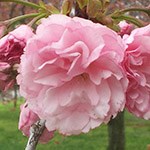
Kwanzan Cherry (Prunus serrulata "Kwanzan") Approximately 13% of the cherry trees in the park.
Habit: an upright-spreading tree to 30 feet, with a rounded crown and stiff ascending branches.
Flowers: double, with about 30 petals, in pendulous clusters of 3 to 5, sometimes more, clear pink and fading but small, up to 2½ inches across, with many more or less petaloid stamens often partly concealing the two green leafy carpels which protrude from the center of the flower.
Zone: Hardy to USDA Hardiness Zone 5: Range of average minimum temperature -10 to -20 degrees Fahrenheit.

Akebono Cherry (Prunus x yedoensis "Akebono") Approximately 3% of the cherry trees in the park.
Habit: a round topped, wide spreading tree that can reach 30 to 50 feet at maturity.
Flowers: single, pale pink that fade to white, in clusters of 2 to 5.
History: This cultivar is losing popularity in the nursery trade and is being replaced with the cultivar Afterglow (Prunus x yedoensis "Afterglow") which has pink blossoms that are deeper in color.
Zone: Hardy to USDA Hardiness Zone 6: Range of average minimum temperature 0 to -10 degrees Fahrenheit.
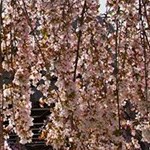
Weeping Cherry (Prunus Subhirtella var. pendula) Approximately 2.4% of cherry trees in the park.
Habit: tree 20 to 40 feet high, with a round-flattened, gracefully, weeping crown.
Flowers: single, pink. This variety is very variable and select cultivars differ in form and color. (i.e., "Pendula Rosea", single deep pink flowers; "Pendula Plena Rosea", double, pink flowers; "Pendula Alba", single, white flowers; "Rosey Cloud", double, bright pink flowers; "Snowfozam", single, white flowers etc.). Zone: Hardy to USDA Hardiness Zone 5: Range of Average minimum temperature -10 to -20 degrees Fahrenheit.
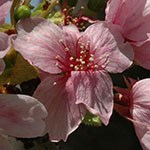
Takesimensis Cherry (Prunus takesimensis) Approximately 5% of cherry trees in the park.
Habit: an upright spreading tree that can reach 30-40 ft. at maturity.
Flowers: white, in large clusters with short pedicels.
History: This species is known to grow in wet locations in its native habitat and is currently being tested in East Potomac Park for tolerance to excessive moisture.
Zone: Hardy to USDA Hardiness Zone 6: Range of Average minimum temperature 0 to -10 degrees Fahrenheit.
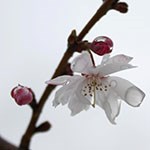
Autumn Flowering Cherry (Prunus subhirtella var. autumnalis) Approximately 3% of cherry trees in the park.
Habit: an upright rounded tree to 25-30 ft. with a 15-20 ft. spread.
Flowers: semi-double, pink. During warm periods in the fall and winter months they will open sporadically and then fully flower the following spring.
Zone: Hardy to USDA Hardiness Zone 4: Range of average minimum temperature -20 to -30 degrees Fahrenheit.

Usuzumi Cherry (Prunus spachiana f. ascendens) Approximately 1.3% of cherry trees in the park.
Habit: tree to 40 ft. with a round, gracefully ascending crown.
Flowers: single, white, truning to grey.
History: The trees in West Potomac Park are from the 1,400+ year old Usuzumi tree growing in the village of Itasho Neo, in Gifu Prefecture of Japan. The Usuzumi tree was declared a National Treasure of Japan in 1922.
Zone: Hardy to USDA Hardiness Zone 6: Range of average minimum temperature 0 to -10 degrees Fahrenheit.
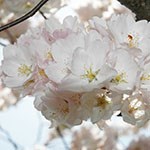
Sargent Cherry (Prunus sargentii) Less than 1% of cherry trees in the park.
Habit: Upright to 40-50 ft. with spreading branches approximately equal to height.
Flowers: single, deep pink, in clusters.
Zone: Hardy to USDA Hardiness Zone 4: Range of Average minimum temperature -20 to -30 degrees Fahrenheit.
Fugenzo Cherry (Prunus serrulata 'Fugenzo')
Habit: up to 20 feet high and 20 feet wide, with a broad crown, often flattened and with the branches intercrossing horizontally.
Flowers: double, about 30 petals, rose pink, becoming lighter with age but never white, up to 2 inches across, in pendulous clusters of 4 to 6. This is one of the oldest cultivated cherry trees in Japan.
Zone: Hardy to USDA Hardiness Zone 6: Range of Average minimum temperature 0 to -10 degrees Fahrenheit.
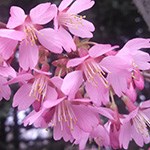
Okame Cherry (Prunus x "Okame") Less than 1% of cherry trees in the park.
Habit: Upright tree to 25 ft. with a 20 ft. spread.
Flowers: semi-double, pink. The earliest flowering cherry.
Zone: USDA Hardiness Zone 5: Range of Average minimum temperature -10 to -20 degrees Fahrenheit. USDA Hardiness Zone 6: Range of Average minimum temperature 0 to -10 degrees Fahrenheit.
Last updated: August 26, 2024
